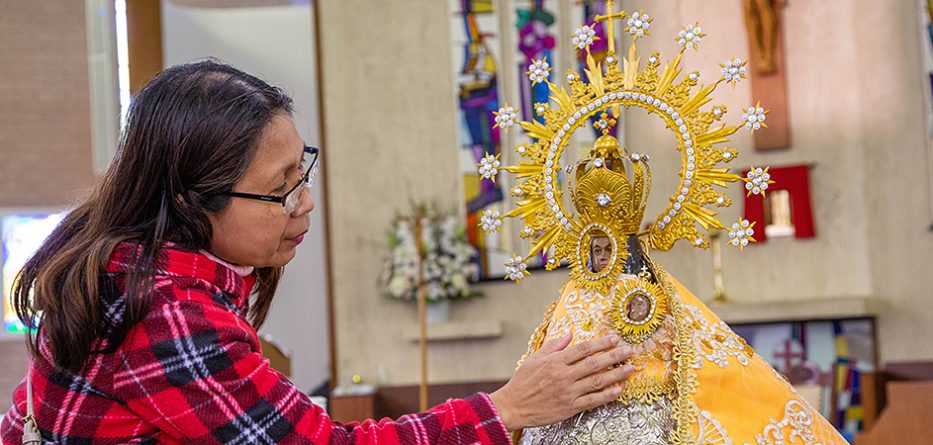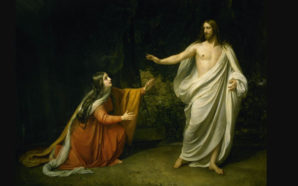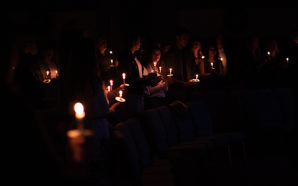Five hundred years ago Christianity arrived in the Philippines. The Catholic Bishops’ Conference of the Philippines (CBCP) began celebrations with a Mass on April 17, 2021, to mark the first Easter Sunday on native soil. The Covid-19 pandemic pushed a key moment for the Church in the Philippines, the International Mission Congress, ahead to April 2022,[1] while other events moved online for accessibility. During the Eucharist celebrated in the Vatican on March 14, 2021, Pope Francis told Philippine Catholics worldwide: “we see the joy of the Gospel in your eyes, on your faces, in your songs, and in your prayers… I want to thank you for the joy you bring to the whole world and to our Christian communities.”[2]
This extended time allows us to give consideration to differing aspects of the quincentennial celebration. On March 18, 2021, government celebration, President Rodrigo Duterte, a known critic of the Catholic Church, did not mention Christianity and focused on native victory over Spanish forces: “I, therefore, call on all our kababayans (countrymen) to appreciate our rich history and learn from the experiences of those that came before us so that we may never again allow any other tribe to compromise our sovereignty.”[3]
Sectors within and outside the Churches marked the milestone by recalling various aspects. For instance, the 2019 conference of the Catholic Theological Society of the Philippines (Dakateo) stressed the perspective of indigenous peoples and echoed earlier demands for Hispano-American apologies.
This essay presents a contextual framework for the Philippine commemoration and articulates Philippine Christianity’s significance as a living heritage social project.
Framework for the Quincentennial
The CBCP’s March 28, 2021 letter, “Celebrating the 500th Year of Christianity in the Philippines”[4] follows the account of the expedition’s chronicler, Antonio Pigafetta, and the following description of the leader, Portuguese Catholic Ferdinand Magellan. He first came as a “mercenary,” but upon seeing the native’s “fertile soil of goodwill” he became a “missionary,” only to revert back to “mercenary” upon realizing native demands. This description is then spiritualized, noting that bearers of the Gospel are “flawed human beings” or, in biblical terms, “earthen vessels.”
Intended as a pastoral exhortation rather than a scholarly account, the statement sets aside historical analyses such as Resil Mojares’ contextualization of Antonio Pigafetta’s chronicle[5] and William Henry Scott’s critique of Magellan’s “religious” role.[6]
The letter aligns with earlier CBCP statements on Christianity’s link with colonization. Some have simplistically identified evangelization with the emergence of the nation.[7] The bishops’ 1998 exhortation on the nation’s centennial acknowledged the problematic link between evangelization and colonialization, using the vague term “ambiguous”: “For our part as an institution, we apologize for the ambiguous stand some Church people held during the revolution, which partly explains the rise of the religious revolution.”[8] They repeatedly stated their wariness about anti-Catholic nationalism, past, and present.
An important document is a one-page statement from Catholic, Protestant, and evangelical Churches, “One Ecumenical Family: A Unity Statement of the Christian Churches on the Occasion of the 500th Year of Christianity in the Philippines.” It confronts the link between Christianity and colonization.[9]
This statement is historic in both content and process. It took a painstaking two-year process, which, though initiated by the Catholic Episcopal Commissions on Ecumenical Affairs and on Mutual Relations, fully engaged leaders from other Christian Churches and associated groups. Drafting committee members bonded through respect and friendship, and overcame past animosities and present differences. Before pandemic health restrictions were put in place, they gathered to pray and discuss in each other’s Churches. When the restrictions came, the Catholic Tanging Yaman Foundation provided relief goods for poor communities served by Protestant and evangelical communities.
This process exemplifies the statement’s historic nature, being the first expression of Christian unity between traditions and Churches. As its title “One Ecumenical Family” suggests, it acknowledges the history of “distrust and acrimony, which have ruptured relationships, not only among ourselves but also with God and all of creation” and thus resolves to “becoming channels of reconciliation.” This ecumenical family makes three substantive points – gratitude for the gift of Christian faith, acknowledgment of contributing to indigenous peoples’ suffering, and common commitment to the marginalized in Philippine society.
First, these Christian leaders express gratitude for the gift of faith: “we, the Christian Churches, give thanks and praise to our loving Triune God for the grace that sustained the faith.” Moreover, they call attention to the valuable work of missionaries: “We are thankful for the countless men and women who offered their lives in fulfilling the mission.”
Second, they acknowledge “that Christianity came along with colonialism under Spain and the United States of America.” The statement decries that “such colonization brought about unprecedented violence and caused suffering to our people, including abuses committed against our indigenous people, and exploitation of our resources, to which some missionary activities contributed.” Nevertheless, it notes “the unrelenting missionary work, such as defending the rights of the natives against the aggression of colonizers and the sowing and cultivation of the Gospel across the archipelago.” Here it implicitly refers to the 1582 Synod of Manila’s defense of natives, as pointed out by historian John N. Schumacher.[10]
Third, the leaders have articulated the current task for all Christians: “In the spirit of renewal, we reaffirm our preferential option for the poor, and our commitment to the protection of the exploited and oppressed, and the promotion of the rights of our indigenous brothers and sisters. We minister anew to those who suffer physically, emotionally, and spiritually. We commit to defend the sacredness of life and the fundamental rights of every human being; support gender equality in morally legitimate ways and promote efforts that advocate a more prominent role for women in the Church and society.” In addition: “We furthermore commit to social justice and a simpler way of life; to engage in peacebuilding and protecting our sovereignty; to address consumerism and climate change. We pledge to pursue all these common advocacies as expressions of faith in our respective traditions and in the spirit of ecumenism.”
Through these emphases, the ecumenical statement provides the appropriate framework. It celebrates the common gift of the Christian faith, and at the same time acknowledges the failures of Christian Churches in witnessing this faith, and outlines focus for the future.
Philippine Christianity as Living Heritage
The gift of faith that Christian leaders celebrate consists of this heritage incarnated in Philippine Christianity and made visible on the local landscape and in the social calendar. Whether rural or urban, outdoor or interior, spaces are marked by Christian signs and symbols: churches and chapels, pilgrimage shrines, altars at workplaces, in homes, and vehicles. Calendars indicate religious occasions: the Christmas and Lenten seasons, as well as the feasts of the Black Nazarene, Santo Niño (Holy Child), and the relevant patron saint.
This ubiquitous presence is the tangible manifestation of Christianity’s encounter with local contexts and its institutionalization in pastoral, social, and educational ministries. This encounter, however, did not spare Christian Churches from external and internal resistance because of colonial links, foreign missionaries’ prejudices, and collusion with the elite.[11]Catholic and Protestant missions experienced schism because of these sentiments: the Iglesia Filipina Independiente from the Catholic Church after the 1898 Revolution and the Evangelical Methodist Church in the Philippine Islands from the Methodist mission in 1909.[12]
But what proved decisive for Philippine Christianity’s development was its use of native languages for evangelization. With its entry under the Patronato Real de las Indias agreement between the papacy and the Spanish monarchy, Catholic leaders chose to evangelize in their native languages rather than Spanish. Carried out while the scattered settlements were being gathered into European-patterned towns, this linguistic strategy initially translated devotional and catechetical materials from Europe, but eventually produced Christian texts in native languages for communal and personal contexts, among them, novenas, catechisms, and lives of saints. With the entry of Protestant missions with American colonialism, translating the New Testament into local languages began in the early 1900s.[13]
This evangelical use of local languages was not the transfer (translation) of a “frozen” and unchanging Christianity into new languages. These languages brought into Christian practice common meanings, emotive associations, and contextual undertones; in effect, creating Christian practice shaped by the native ethos.[14] Native Christians became empowered to speak to and about God in their own native tongues.
Thus the gift of faith was incarnated through translation “involv[ing] the interface of languages, semiotic systems, cultural products, and systems of cultural organization, and it makes manifest the differences and similarities of systems across cultures.”[15] In the end, what is translated into people’s lives is more than Christian vocabulary. It is the Christian story itself. Even with a growing number of Christians educated in English from the American colonial period onward, religious sensibility has remained rooted in the local context.
Moreover, this heritage, far from being a fossil from the past, remains vibrant as it enters new global contexts. With increased mobility, Philippine Christians bring their heritage to ministries in international pastoral contexts and organizations like the Federation of Asian Bishops’ Conferences and the World Council of Churches.
More recently, Catholic and Protestant laity have undertaken foreign missions. Those from evangelical and charismatic communities have established chapters open to different nationalities. Others go abroad as migrants and workers, but bring expressions of their Philippine Christian heritage; for instance, rosaries and Bibles as well as Christmas novena Masses and local Marian processions. They have thus been called “the new missionaries.”[16]
This heritage proved resilient during the Covid-19 pandemic. Joseph Remus F. Galang et al. have described liturgical adaptations and innovations.[17] Under strict lockdowns and through social media platforms and initiatives involving music and videos, online worship became accessible to greater participation beyond regular parish services. It engages more participants from diverse geographical locations and spiritual heritages.[18]
This digital migration of the Philippine Christian heritage also initiated ministries for sectors more adversely affected by the pandemic: those suffering from endemic poverty as well as those newly unemployed, like returning overseas workers.[19] Online Christian communities became hubs of social ministry for development programs, distributing produce bought from distressed agricultural workers, and assisting vulnerable communities, including those of the Muslim faith. These Christian efforts manifest diversity and inclusiveness among all those involved: benefactors, volunteers, and recipients.
These pandemic responses exemplify the vibrant and resilient heritage of Philippine Christianity. As the Galang study indicates, Philippine Christians “manifest the values of pakikisama (solidarity), pakikiramay (empathy) and pagkakaisa (unity), not only through physical distancing, but also by reaching out to those in need amidst the fear of infection.” These reflect “a lived experience of God’s kagandahang-loob (loving-kindness).”[20] Thus Philippine Christianity’s heritage offers some glimpse of “social friendship” which, according to Pope Francis’s Fratelli Tutti, consists of “love capable of transcending borders” (FT 99), and acknowledges “the worth of every human person, always and everywhere” (FT 106).
Philippine Christianity as Social Project
After expressing gratitude for the gift of faith and apologies on account of people’s suffering and environmental degradation, Christian leaders have issued a common call to action: reaffirming the preferential option for the poor, protection of the oppressed, and the rights of indigenous peoples. They further commit to defending the sacredness of life and the fundamental rights of every human being; supporting gender equality in morally legitimate ways and promoting efforts that advocate a more prominent role of women in the church and society. These involve a simpler way of life, engaging in peacebuilding, protecting national sovereignty, and addressing consumerism and climate change. Thus the call involves nothing less than a major social project for Philippine Christianity.
This project follows Fratelli Tutti’s integration of social friendship with political love: “love, overflowing with small gestures of mutual care, is also civic and political, and it makes itself felt in every action that seeks to build a better world. For this reason, charity finds expression not only in close and intimate relationships but also in macro-relationships: social, economic and political” (FT 181).
Moreover, this project takes shape in the context of Philippine politics. According to the CBCP’s 1997 pastoral exhortation, “Philippine politics – the way it is practiced – has been most hurtful to us as a people” and “is possibly the biggest bane in our life as a nation and the most pernicious obstacle to our achieving of full human development.”[21] It “has degenerated into an arena where the interests of the powerful and rich few are pitted against those of the many weak and poor” and “interferes with the administration of justice and the equal application of the law, as it is patently heavily weighted on the side of the politically connected.”[22] Because of established practices governed by self-interest and patronage, as well as fraudulent activities before, during, and after elections, numerous CBCP letters to Catholics to vote wisely have proved ineffective. This parlous situation has become further entrenched during Duterte’s presidency.[23]
Given this context, Philippine Christianity’s social project requires strategic direction. First and most evidently, it must engage in political education, understood not as traditional politics but as Fratelli Tutti’s social friendship and political love. Political education then becomes an integral systematic part of all formation programs in ecclesial ministries and institutions.
Moreover, its methodology transcends the traditional approaches in earlier CBCP statements, by applying general principles of “Gospel values” to specific issues.[24] It must consider the dynamic interplay between Christian faith and the particularities of actual situations, an interplay that uncovers nuances in the meaning of Christian faith itself. Laymen and women take center stage in this political education because of their numbers and the Vatican II mandate toward “the penetrating and perfecting of the temporal order through the spirit of the Gospel” (Apostolicam Actuositatem, No. 2). Such education by and for the laity could help overcome their own collusion with familial and regional patronage.
Second, Philippine Christianity must disentangle itself from traditional politics. Church leaders share official and unofficial bonds with politicians, reinforced by traditional person-oriented culture. Church-state relations must be based, first and foremost, on cooperation for the common good, especially for the marginalized, following established constitutional provisions.
This disentanglement ad extra corresponds to the internal aggiornamento of Christianity’s institutional culture and communal processes. Institutional renewal considers how certain traditional values could reinforce clericalism, as Aloysius Lopez Cartagenas points out: “Their (clerics’) gender and ethnic provenance hold the key to understanding the various forms of dysfunctions concerning sexuality and intimacy, sex and gender, power and authority to which they are socialized early on and in which they move and have they’re being for the rest of their lives.”[25] To ignore this could diminish women’s participation in communities and undermine inclusivity, transparency, and accountability within the Church.
Third, Christian Churches must cast a wider net of moral suasion and collaborative praxis based on the common good in both physical and digital spaces. In particular, this net needs to encompass those at the margins of the Church and society, who are identified by the shared ecumenical statement as indigenous peoples, women the poor majority and are central to the social project of Philippine Christianity. For instance, though Christian Churches minister to many among the poor through pastoral and social centers, significant numbers still remain at their margins. Thus notwithstanding its pledge in its 1991 Second Plenary Council of the Philippines to become the “Church of the Poor,” the Catholic Church needs greater efforts to “be in solidarity with the poor” and “collaborate with the poor themselves and with others to lift up the poor from their poverty.”[26]
This immense social project can only be addressed by harnessing all possible platforms. Given the 2020 number of 79.66 million internet users out of the population of 109 million,[27] Christian Churches could counter traditional politicians’ invasion of digital platforms and build on their online experience during the pandemic to become “influencers” of internet-literate youth.[28] In order to reach and influence more, all Christian Churches must cooperate among themselves and with others in Philippine society.
Conclusion
With the culmination of the quincentennial celebration of Christianity’s arrival, all Philippine Christians have indeed much to celebrate. They can be grateful for the profound gift of faith, incarnated in a living heritage shaping personal and communal lives and institutionalized in pastoral, educational, and social ministries. More than just a collection of religious traditions and customs or a set of cultural qualities reflected in joyous music and smiling faces, this heritage remains vibrant as it encounters new and unsettling challenges. As shown in its responses to the global Covid-19 pandemic, Philippine Christianity has been resourceful and resilient in serving the faithful and those whose lives and livelihoods have been deeply affected by the pandemic. Church worship, both online and limited in-person, has continued to nourish, even strengthen, the faith at this most unsettling time.
However, together with this gratitude, which cannot be self-serving or triumphalistic, we must acknowledge the need to continue to deepen our faith in Christ, translating it into the social project articulated in the ecumenical statement we have examined. Addressed to all Philippine Christians, this project of building social structures of justice and equality, summed up in Fratelli Tutti’s phrase “political love,” undermines Philippine traditional politics responsible for “the death of development.” Christian Churches then must integrate political education in its formation, distance themselves from traditional political practice, and partner with all those working for the common good.
Thus the living heritage and social projects of Philippine Christianity invite each Church to journey together with the people. To borrow Pope Francis’s words: “inasmuch as the Church is nothing other than the ‘journeying together’ of God’s flock along the paths of history toward the encounter with Christ the Lord, then we understand too that, within the Church, no one can be ‘raised up’ higher than others” and “that each person ‘lower’ himself or herself, so as to serve our brothers and sisters along the way.”[29] Since its arrival five hundred years ago, this has marked the path forward for Philippine Christianity.
Jose Mario C Francisco, SJ is the Professor of Philosophical and Systematic Theology, Ateneo de Manila University.
Reproduced with permission from La Civiltà Cattolica.
[1] Cf. “Church Pushes Back 500 Years of Christianity Celebration due to Covid-19”, in CBCPNews (cbcpnews.net/cbcpnews/church-pushes-back-500-years-of-christianity-celebration-due-to-covid19), September 24, 2020.
[2] Francis, Homily during the Mass for 500 Years of Evangelization of the Philippines, March 14, 2021.
[3] D. de Leon, “Don’t compromise sovereignty, says Duterte on 500th year of Magellan’s arrival”, in Rappler (www.rappler.com/nation/duterte-wants-filipinos-reject-compromise-sovereignty-magellan-expedition-commemoration-2021), March 18, 2021.
[4] Cf. “Pastoral letter Celebrating the 500th Year of Christianity in the Philippines”, in CBCPNews (https://cbcpnews.net/cbcpnews/pastoral-letter-celebrating-the-500th-year-of-christianity-in-the-philippines/), March 23, 2021.
[5] Cf. R. B. Mojares, Waiting for Mariang Makiling: Essays in Philippine Cultural History, Quezon City, Ateneo de Manila University Press, 2002, 20-51.
[6] Cf. W. H. Scott, Looking for the Prehispanic Filipino, Quezon City, New Day Publishers, 1992, 40-63.
[7] Cf. P. C. Quitorio III (ed), Pastoral Letters 1945-1995, Manila, CBCP publications, 1996, 237.
[8] Cf. idem (ed), CBCP: On the Threshold of the Next Millennium, ibid., 1999, 150.
[9] Cf. “One Ecumenical Family: A Unity Statement of the Christian Churches on the Occasion of the 500th Year of Christianity in the Philippines”, in CBCPNews (https://cbcpnews.net/cbcpnews/one-ecumenical-family).
[10] Cf. J. N. Schumacher, Readings in Philippine Church History, Quezon City, Loyola School of Theology, 1979, 28.
[11] Cf. J. N. Schumacher, Revolutionary Clergy: The Filipino Clergy and the Nationalist Movement, 1850-1903, Quezon City, Ateneo de Manila University Press, 1981.
[12] Cf. M. D. Clifford, “Iglesia Filipia Independiente: The Revolutionary Church”, in G.H. Anderson (ed), Studies in Philippine Church History, Ithaca, Cornell University Press, 1969, 223-255; Ruben F. Trinidad, “Nicolas Zamora and the IEMELIF Church”, in Chapters in Philippine Church History, Mandaluyong City, OMF Literature, 2001, 203-224.
[13] Cf. A. C. Kwantes, “The Bible Society in the Philippines: The Story of Bible Society Work”, in idem, (ed), Chapters in Philippine Church History, 463-481.
[14] Cf. J. M. C. Francisco, “Fidelity in Translating Religious Practice: Illustrations from Filipino Christianity”, in Kritika Kultura Nos. 21-22, 2013, 204-219.
[15] M. Tymoczko, Enlarging Translation, Empowering Translators, Manchester, St. Jerome, 2010, 8.
[16] J. M. C. Francisco, “Migration and the New Cosmopolitanism in Asian Christianity”, in F. Wilfred (ed), The Oxford Handbook of Asian Christianity, New York, Oxford University Press, 2014, 757-792.
[17] J. R. F. Galang et al., “Social Distancing as a Recontextualization of Filipino Values and Catholic Religious Practices”, in Journal of Religion and Health 60 (2021/5) 3245-3264 (www.ncbi.nlm.nih.gov/pmc/articles/PMC8322637/).
[18] Cf. B. A. Musa, “Reimagining Place and Presence in the Virtual Church: Community and Spiritual Connection in the Digital Era”, in H.A. Campbell (ed), Digital Ecclesiology, Digital Religion Publication, 2020 : (www.researchgate.net/publication/344001719_Digital_Ecclesiology_A_Global_Conversation _ Ebook_edited_by_Heidi_Campbell)
[19] Cf. E. C. de Jesus – M. S. Dayrit – I. S. Baysic (eds), Countering Covid-19: Cases in Crisis Response, Quezon City, Ateneo de Manila University Press, 2021.
[20] J. R. F. Galang et al., “Social Distancing…”, op. cit.
[21] P. C. Quitorio III (ed), CBCP: On the Threshold of the Next Millennium, Manila, CBCP Publications, 1999, 89.
[22] Ibid., 89f.
[23] N. Curato, “We Need to Talk about Rody”, in N. Curato (ed), A Duterte Reader: Critical Essays on Rodrigo Duterte’s Early Presidency, Quezon City, Ateneo de Manila University Press, 2017, 8; M. R. Thompson, “Duterte’s Violent Populism: Mass Murder, Political Legitimacy and the Death of Development in the Philippines”, in Journal of Contemporary Asia: https://www.tandfonline.com/loi/rjoc20), April 16, 2021.
[24] J. M. C. Francisco, “People of God, People of the Nation: Official Catholic Discourse on Nation and Nationalism”, in Philippine Studies 62/3-4 (2014/3-4), 341-375.
[25] A. L. Cartagenas, “The Terror of the Sexual Abuse by Roman Catholic Clergy and the Philippine Context”, in Asian Horizons 5 (2011/2) 371.
[26] Acts and Decrees of the Second Plenary Council of the Philippines, Manila, Catholic Bishops’ Conference of the Philippines, 1992, 49f.
[27] “Internet Penetration Rate in the Philippines from 2017 to 2020, with forecast until 2026”, in Statista (www.statista.com/statistics/975072/internet-penetration-rate-in-the-Philippines/).
[28] Cf. J. S. Cornelio, Being Catholic in Contemporary Philippines: Young People Reinterpreting Religion, London – New York, Routledge, 2016, 163.
[29] Francis, Address on the occasion of the 50th anniversary of the Synod of Bishops, October 17, 2015.








